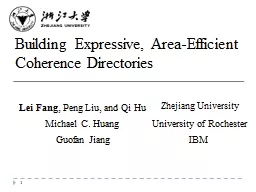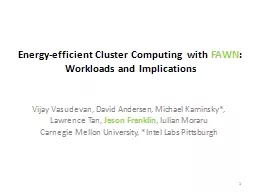PPT-Building Expressive, Area-Efficient
Author : danika-pritchard | Published Date : 2017-06-14
Coherence Directories Michael C Huang Guofan Jiang Zhejiang University University of Rochester IBM 1 Lei Fang Peng Liu and Qi Hu Motivation 2 Technology scaling
Presentation Embed Code
Download Presentation
Download Presentation The PPT/PDF document "Building Expressive, Area-Efficient" is the property of its rightful owner. Permission is granted to download and print the materials on this website for personal, non-commercial use only, and to display it on your personal computer provided you do not modify the materials and that you retain all copyright notices contained in the materials. By downloading content from our website, you accept the terms of this agreement.
Building Expressive, Area-Efficient: Transcript
Download Rules Of Document
"Building Expressive, Area-Efficient"The content belongs to its owner. You may download and print it for personal use, without modification, and keep all copyright notices. By downloading, you agree to these terms.
Related Documents














